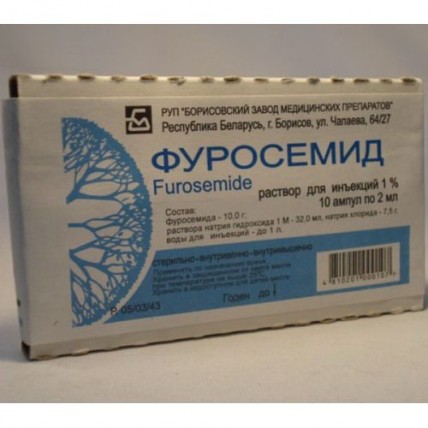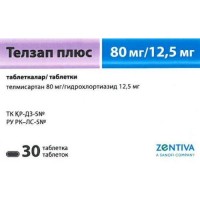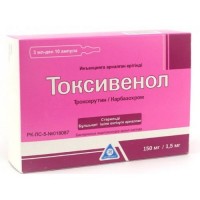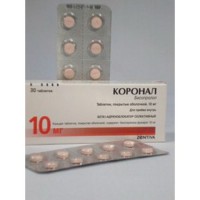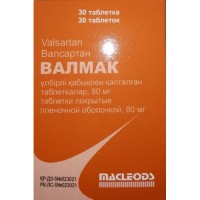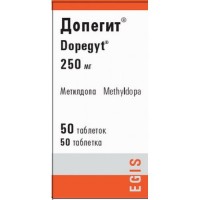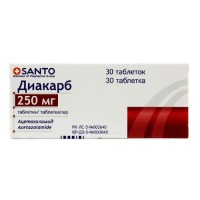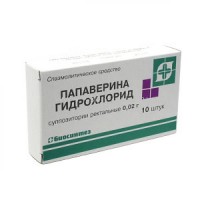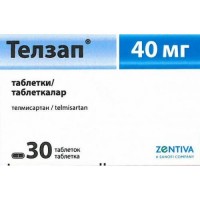Furosemide 1% / 2 ml 10s solution for injection in ampoules
- $2.70
The instruction for medical use
of medicine
Furosemide
the Trade name
Furosemide
the International unlicensed
name Furosemide Dosage Form Solution for injections of 10 mg/ml
One ampoule contains Structure:
active agent – furosemide of 20 mg,
excipients: solution of sodium of hydroxide of 1 M, sodium chloride, water for injections.
Description
Transparent colourless or slightly yellowish color liquid.
Pharmacotherapeutic
Loopback group diuretics. Sulfanamide diuretics. Furosemide.
The ATX C03CA01 code
the Pharmacological
Pharmacokinetics At properties intravenous administration effect of furosemide develops in 5 - 10 min., time of achievement of the maximum concentration (TCmax) at intravenous administration – 30 min., the diuretic effect proceeds within 2 hours, at reduced function of kidneys - up to 8 h.
The relative volume of distribution – 0.2 l/kg. Communication with proteins of plasma - 98%. It is metabolized in a liver with formation of 4-chlorine-5-sulfamoylanthranilic acid. Cosecretes in a gleam of renal tubules through the system of transport of anions existing in proximal department of nephron. Clearance – 1.5 - 3 ml/min. Elimination half-life of furosemide after intravenous administration makes from 1 to 1.5 hours.
It is removed mainly (88%) by kidneys in an invariable look and in the form of metabolites, with a stake – 12%.
Furosemide is emitted in breast milk. Furosemide passes a placental barrier and slowly gets to a fruit. It is found in an organism of a fruit or in an organism of newborns in the same concentration as mother's organism.
A pharmacodynamics
Furosemide effective, quickly and quickly operating loopback diuretic. Furosemide high-speed diuretic with the significant diuretic effect, renders the significant diuretic, natriuretic, chloruretichesky effect, increases removal of potassium ions, calcium, magnesium. Oppresses a reabsorption of ions of sodium, chlorine generally in a thick segment of the ascending part of a Henle's loop. Therefore the efficiency of diuretic effect of Furosemide depends on achievement by medicine of level of renal tubules via the anion transport mechanism. Diuretic action is caused by suppression of a reabsorption of ions of chlorine and sodium in this segment of a Henle's loop. As a result, partial discharge of sodium can reach 35% of glomerular filtration of sodium. The strengthened urine discharge (as a result of osmotically connected water) and increase in secretion of potassium ions in a distal part of renal tubules is a consequence of increase in secretion of sodium. Also discharge of calcium and magnesium increases.
In heart failure in 20 min. leads to decrease in preload of heart. The maximum hemodynamic effect is reached by the second o'clock of effect of drug that is caused by decrease in a tone of venous vessels, reduction of volume of the circulating blood and intercellular liquid. Has hypotensive effect owing to increase in removal of sodium of chloride, decrease in reaction of smooth muscles of vessels to vasopressor influences and as a result of reduction of volume of the circulating blood.
During action the removal of ions of sodium considerably increases, however after its termination the clearance rate decreases below the initial level (syndrome of ricochet or cancellation). The phenomenon is caused by sharp activation renin-angiotenzinovogo and other anti-natriuretic neurohumoral links of regulation in response to a massive diuresis, stimulates argininvazopressivny and sympathetic systems. Reduces the level of an atrial natriuretic factor in plasma, causes vasoconstriction. Owing to a phenomenon of ricochet at introduction of 1 times a day can not have significant effect on daily removal of sodium and arterial blood pressure.
At intravenous administration in a dose of 20 mg the beginning of diuretic effect is observed in 15 minutes and duration is about 3 hours.
Continuous infusion of Furosemide is more effective, than repeated injections of a shock drug dose. Important the fact that the dose over a certain shock dose of medicine has no considerable effect. Effect of Furosemide decreases at patients with reduced tubular secretion or at intra tubular linking of medicine with proteins.
Indications
- an edematous syndrome in chronic heart failure, an acute heart failure, chronic kidney disease, a nephrotic syndrome (at a nephrotic syndrome in the forefront there is a treatment of a basic disease)
- an edematous syndrome in liver diseases
- wet brain
- hypertensive crisis, severe forms of arterial hypertension
- maintenance of an artificial diuresis in poisonings with chemical compounds, the removed kidneys in an invariable look.
Route of administration and doses
Intravenously and intramusculary. It is recommended to use the minimum dose of drug rendering therapeutic effect.
At intravenous administration, furosemide should be entered slowly. Rate of administering should not exceed 4 mg a minute. To patients with heavy disturbance of renal function (creatinine level in serum & gt, 5 mg/ml) the rate of administering of 2.5 mg a minute is recommended not to exceed.
Intramuscular introduction is possible in exceptional cases when it is impossible to apply an intravenous or oral way of administration of drug. The intramuscular way of introduction is impossible at treatment of acute conditions (for example, a fluid lungs).
Transition from a parenteral form to peroral has to be carried out as soon as possible.
The issue of duration of treatment is resolved by the doctor, considering character and severity of a disease.
The edematous syndrome
to Adults and children is more senior than 15 years appoint in an initial dosage from 20 to 40 mg of furosemide (1-2 ampoules) intravenously, in exceptional cases, intramusculary. Natriuretic reaction of Furosemide depends on a number of factors, including weight of a renal failure and sodium balance therefore the effect of a dosage cannot be precisely calculated. For patients with chronic kidney disease the dose of Furosemide has to be carefully a protitrovana so that initial loss of liquid was gradual. The dose which leads to liquid loss is approximately equal to 2 kg of body weight (about 280 mmol of sodium) a day. The dose should be adjusted as necessary according to the clinical answer. At intravenous administration of Furosemide begin to enter by continuous intravenous infusion in a dose 0.1 mg a minute, then gradually increasing rate of administering everyone half an hour taking into account the clinical answer. In high doses (80 – 240 mg and above) enter intravenously by drop infusion, with a speed not higher than 4 mg/min. The maximum daily dose – 600 mg.
The patient with reduced glomerular filtration and the low diuretic answer appoint in high doses - 1-1.5 g. The maximum single dose - 2 g.
The artificial diuresis in poisonings
From 20 to 40 mg of furosemide (1 - 2 ampoules) is in addition added to infusion electrolytic solution. Further treatment is carried out depending on the volume of a diuresis and has to compensate the lost amount of liquid and electrolytes.
Hypertensive crisis
the Recommended initial dose for intravenous administration makes from 20 to 40 mg. The dose should be adjusted as necessary according to the clinical answer.
Children up to 15 years
the Average daily dose for intravenous or intramuscular administration at children up to 15 years - 0.5-1.5 mg/kg.
Side effects
- a lowering of arterial pressure, orthostatic hypotension, collapse, tachycardia, arrhythmias, decrease in volume of the circulating blood
- dizziness, a headache, paresthesias, apathy, an adynamia, weakness, slackness, drowsiness, confusion of consciousness
- a disorder of vision and hearing
- a loss of appetite, dryness in a mouth, thirst, nausea, vomiting, diarrhea or a constipation, cholestatic jaundice, pancreatitis (aggravation)
- an oliguria, a sharp ischuria (at patients with a prostatauxe), interstitial nephrite, a hamaturia, decrease in potency
- a purpura, urticaria, exfoliative dermatitis, a multiformny exudative erythema, a vasculitis, a necrotizing angiitis, a skin itching, a fever, fever, a photosensitization, an acute anaphylaxis
- a leukopenia, thrombocytopenia, an agranulocytosis, aplastic anemia
- a hypovolemia, dehydration (risk of developing thrombosis and thrombembolia), a hypopotassemia, a hyponatremia, a hypochloraemia, a hypocalcemia, a hypomagnesiemia, a metabolic alkalosis
- muscle weakness, spasms of gastrocnemius muscles (tetany)
- a hyperglycemia, a hypercholesterolemia, a hyperuricemia, a glucosuria,
a hypercalcuria
- thrombophlebitis, calcification of kidneys at premature children
of the Contraindication
- the hypersensitivity to furosemide or to any component of drug, streptocides or to sulphonylurea drugs, can develop cross hypersensitivity to furosemide
- an acute glomerulonephritis, an acute renal failure with an anury (the size of glomerular filtration less than 3 - 5 ml/min.)
- a heavy liver failure, a hepatic coma and a prekoma
- an urethra stenosis, obstruction of urinary tract a stone
- prekomatozny states
- a hyper glycemic coma
- a hyperuricemia, gout
- a dekompensirovanny mitral or aortal stenosis, a hypertrophic subaortic stenosis, increase in the central venous pressure (over 10 mm Hg.), arterial hypotension, an acute myocardial infarction
- pancreatitis
- disturbance of water and electrolytic exchange and acid-base equilibrium (hypopotassemia, an alkalosis, a hypovolemia, a hyponatremia, a hypochloraemia, a hypocalcemia, a hypomagnesiemia), digitalis intoxication
- the breastfeeding period
- the I trimester of pregnancy
not recommended combinations
In some cases intravenous prescribing of furosemide within 24 hours after intake of Chlorali hydras can lead Medicinal interactions to rushes of blood, excess sweating, concern, nausea, increase in arterial blood pressure, tachycardia. Therefore joint intake of furosemide and Chlorali hydras is not recommended.
Ototoxicity of aminoglycosides and other ototoksichny drugs can amplify at simultaneous use of furosemide. As the hearing disorder arising at the same time can be irreversible, simultaneous use vozmozhnopo to vital indications.
The combinations demanding special precautions
At simultaneous use of a furosemd and Cisplatinum risk of development of ototoksichesky action is possible. If at treatment by Cisplatinum achievement of an artificial diuresis by means of Furosemide is necessary, then the last can be appointed only in a low dosage (for example, 40 mg at normal function of kidneys) and in the absence of deficiency of liquid. Otherwise strengthening of nephrotoxic effect of Cisplatinum is possible.
Under the influence of Furosemide the lithium removal decreases at the expense of what the damaging impact of lithium on heart and nervous system amplifies. Levels of lithium have to monitorirovatsya carefully at the patients receiving this combination.
Treatment by Furosemide can lead to heavy hypotension and deterioration in function of kidneys, and in some cases – to development of an acute renal failure, especially when prescribing inhibitors of the angiotensin-converting enzyme (ACE) or antagonists of receptors of angiotensin II for the first time or at the first reception in the raised dose. Furosemide cancellation, or reduction of a dose of furosemide in 3 days prior to treatment by APF inhibitors or antagonists of receptors of angiotensin II is recommended.
With care it is necessary to apply furosemide in a combination with risperidony. At elderly patients with weak-mindedness mortality at combined use of furosemide and a risperidon increases. Need of combined use has to be proved taking into account risk and advantage of this combination.
Including acetylsalicylic acid, the effect of Furosemide can lower combinations which it is necessary to take Co-administration of non-steroidal anti-inflammatory drugs (NPVS) into account. With dehydration or a hypovolemia of NPVS can cause an acute renal failure in patients. At the same time the toxic effect of salicylates can increase.
Also decrease in efficiency of furosemide at Phenytoinum co-administration is described.
At simultaneous treatment by glucocorticosteroids, karbenoksolony, a licorice in large amounts, prolonged use of laxatives the hypopotassemia can amplify.
The possible hypopotassemia or a hypomagnesiemia can increase sensitivity of a cardiac muscle to the cardiac glycosides and medicines leading to lengthening of an interval of QT.
Effect of other medicines reducing the arterial blood pressure (ABP) (antihypertensive, diuretic and other drugs) can be strengthened at simultaneous use with furosemide.
Simultaneous use of a probenetsid, methotrexate and other means which are removed by canalicular secretion (as well as furosemide) can reduce efficiency of furosemide. On the other hand furosemide can lead to decrease in renal elimination of these medicines.
At treatment by high doses (furosemide and other drugs) increase in their levels in blood serum and increase in risk of development of side effects is possible.
Efficiency of hypoglycemic means and pressor amines (for example, epinephrine (adrenaline), Norepinephrinum (noradrenaline), it can be weakened, and theophylline and kurarepodobny means – it is strengthened.
Furosemide can strengthen the damaging action on kidneys of nephrotoxic drugs.
At the patients who are at the same time receiving treatment by furosemide and some cephalosporins in high doses the deterioration in renal function is possible.
At simultaneous use of cyclosporine A and furosemide the increase in risk of developing secondary gouty arthritis owing to the Furosemide-induced hyperuricemia and deterioration in the removal of urates kidneys caused by cyclosporine is possible.
The patients with high risk of development of a radio contrast nephropathy receiving treatment by furosemide are more subject to disturbances of renal function after receiving radiocontrast substance in comparison with patients with high risk which received only intravenous hydration before receiving radiocontrast substance.
Intravenously entered furosemide has slightly alkali reaction therefore it cannot be mixed with drugs with rn less than 5.5.
Special instructions
Against the background of treatment it is necessary to control periodically arterial blood pressure, content of electrolytes of plasma (Na, Ca, K, Mg), an acid-base condition, residual nitrogen, creatinine, uric acid, function of a liver and to carry out, if necessary, the corresponding correction of treatment (with bigger frequency rate at patients with frequent vomiting and against the background of parenterally entered liquids).
Patients with hypersensitivity to streptocides and derivatives of sulphonylurea can have cross sensitivity to furosemide.
To the patient receiving high doses of furosemide in order to avoid development of a hyponatremia and a metabolic alkalosis it is inexpedient to limit consumption of table salt.
For prevention of a hypopotassemia the co-administration of drugs of potassium and kaliysberegayushchy diuretics is recommended (first of all Spironolactonum) and also to adhere to the diet rich with potassium.
The increased risk of development of disturbances of water and electrolytic balance is noted at patients with a renal failure.
Selection of the mode of dosing by the patient with ascites against the background of cirrhosis needs to be carried out in stationary conditions (disturbances of water and electrolytic balance can entail development of a hepatic coma). Regular control of the content of electrolytes in plasma is shown to this category of patients.
At emergence or strengthening of an azotemia and oliguria in patients with the serious progressing illness of kidneys it is recommended to suspend treatment.
Periodic control of glucose level in blood and urine is required from patients with diabetes or with reduced tolerance to glucose.
At patients in unconsciousness, with a prostatauxe, narrowing of ureters or a hydronephrosis the control of a mocheotdeleniye in connection with a possibility of a sharp ischuria is necessary.
Use during pregnancy and a lactation
At pregnancy (especially the first half) furosemide is accepted according to vital indications after careful assessment of a ratio of advantage for mother/risk for a fruit.
It is allocated with milk at women in the period of a lactation and suppresses a lactation, in need of use of drug it is reasonable to stop chest feeding.
The feature of influence of medicine on ability to run the vehicle or potentially dangerous mechanisms
during treatment should avoid occupations potentially dangerous types of activity requiring special attention and speed of psychomotor reactions.
Overdose
Symptoms: the significant decrease in the ABP, collapse, shock, a hypovolemia, dehydration, haemo concentration, arrhythmias (including AV blockade, fibrillation of ventricles), an acute renal failure with an anury, thrombosis, a thrombembolia, drowsiness, confusion of consciousness, sluggish paralysis, apathy.
Treatment: correction of water-salt balance and an acid-base state, completion of volume of the circulating blood, symptomatic treatment. There is no specific antidote.
A form of release and packing
On 2 ml in ampoules from glass.
On 10 ampoules together with a knife or the scarificator for opening of ampoules put in a box of cardboard with a corrugated insert from paper.
The box is pasted over with the label parcel post from paper for the polichromatic press.
Boxes together with iinstruktion on use in the state and Russian languages pack into group packing.
The number of instructions on has to correspond to the number of packs.
In case of use of ampoules with a ring of a break or with a notch and a point of a break, the investment of a knife or the scarificator for opening of ampoules is not provided.
Or on 10 ampoules place in an insert from a film polyvinylchloride. On 1 insert with ampoules together with a knife or the scarificator for opening of ampoules and the instruction for medical use in the state and Russian languages place in a pack from cardboard chrome ersatz.
Or 10 ampoules together with a knife or the scarificator for opening of ampoules and the instruction for medical use in the state and Russian languages place in a pack from cardboard with a cardboard insert for fixing of ampoules.
Storage conditions
In the place protected from light, at a temperature not above 25 °C.
To protect from children!
2 years
not to apply a period of storage after expiry date.
Prescription status
According to the prescription
the Borisovsky Plant of Medications Open joint stock company Producer, Republic of Belarus, Minsk Region, Borisov, Chapayev St., 64/27,
ph. / fax 8-(10375177) 744280.
The owner of the registration certificate
Borisovsky Plant of Medications Open joint stock company, Republic of Belarus
to Develop the Address of the organization accepting in the territory of the Republic of Kazakhstan claims from consumers on quality of products (goods) Borisovsky Plant of Medications Open joint stock company, Republic of Belarus, Minsk Region, Borisov, Chapayev St., 64/27, ph. / fax 8-(10375177) 744280, the e-mail address of market@borimed.com
of medicine
Furosemide
the Trade name
Furosemide
the International unlicensed
name Furosemide Dosage Form Solution for injections of 10 mg/ml
One ampoule contains Structure:
active agent – furosemide of 20 mg,
excipients: solution of sodium of hydroxide of 1 M, sodium chloride, water for injections.
Description
Transparent colourless or slightly yellowish color liquid.
Pharmacotherapeutic
Loopback group diuretics. Sulfanamide diuretics. Furosemide.
The ATX C03CA01 code
the Pharmacological
Pharmacokinetics At properties intravenous administration effect of furosemide develops in 5 - 10 min., time of achievement of the maximum concentration (TCmax) at intravenous administration – 30 min., the diuretic effect proceeds within 2 hours, at reduced function of kidneys - up to 8 h.
The relative volume of distribution – 0.2 l/kg. Communication with proteins of plasma - 98%. It is metabolized in a liver with formation of 4-chlorine-5-sulfamoylanthranilic acid. Cosecretes in a gleam of renal tubules through the system of transport of anions existing in proximal department of nephron. Clearance – 1.5 - 3 ml/min. Elimination half-life of furosemide after intravenous administration makes from 1 to 1.5 hours.
It is removed mainly (88%) by kidneys in an invariable look and in the form of metabolites, with a stake – 12%.
Furosemide is emitted in breast milk. Furosemide passes a placental barrier and slowly gets to a fruit. It is found in an organism of a fruit or in an organism of newborns in the same concentration as mother's organism.
A pharmacodynamics
Furosemide effective, quickly and quickly operating loopback diuretic. Furosemide high-speed diuretic with the significant diuretic effect, renders the significant diuretic, natriuretic, chloruretichesky effect, increases removal of potassium ions, calcium, magnesium. Oppresses a reabsorption of ions of sodium, chlorine generally in a thick segment of the ascending part of a Henle's loop. Therefore the efficiency of diuretic effect of Furosemide depends on achievement by medicine of level of renal tubules via the anion transport mechanism. Diuretic action is caused by suppression of a reabsorption of ions of chlorine and sodium in this segment of a Henle's loop. As a result, partial discharge of sodium can reach 35% of glomerular filtration of sodium. The strengthened urine discharge (as a result of osmotically connected water) and increase in secretion of potassium ions in a distal part of renal tubules is a consequence of increase in secretion of sodium. Also discharge of calcium and magnesium increases.
In heart failure in 20 min. leads to decrease in preload of heart. The maximum hemodynamic effect is reached by the second o'clock of effect of drug that is caused by decrease in a tone of venous vessels, reduction of volume of the circulating blood and intercellular liquid. Has hypotensive effect owing to increase in removal of sodium of chloride, decrease in reaction of smooth muscles of vessels to vasopressor influences and as a result of reduction of volume of the circulating blood.
During action the removal of ions of sodium considerably increases, however after its termination the clearance rate decreases below the initial level (syndrome of ricochet or cancellation). The phenomenon is caused by sharp activation renin-angiotenzinovogo and other anti-natriuretic neurohumoral links of regulation in response to a massive diuresis, stimulates argininvazopressivny and sympathetic systems. Reduces the level of an atrial natriuretic factor in plasma, causes vasoconstriction. Owing to a phenomenon of ricochet at introduction of 1 times a day can not have significant effect on daily removal of sodium and arterial blood pressure.
At intravenous administration in a dose of 20 mg the beginning of diuretic effect is observed in 15 minutes and duration is about 3 hours.
Continuous infusion of Furosemide is more effective, than repeated injections of a shock drug dose. Important the fact that the dose over a certain shock dose of medicine has no considerable effect. Effect of Furosemide decreases at patients with reduced tubular secretion or at intra tubular linking of medicine with proteins.
Indications
- an edematous syndrome in chronic heart failure, an acute heart failure, chronic kidney disease, a nephrotic syndrome (at a nephrotic syndrome in the forefront there is a treatment of a basic disease)
- an edematous syndrome in liver diseases
- wet brain
- hypertensive crisis, severe forms of arterial hypertension
- maintenance of an artificial diuresis in poisonings with chemical compounds, the removed kidneys in an invariable look.
Route of administration and doses
Intravenously and intramusculary. It is recommended to use the minimum dose of drug rendering therapeutic effect.
At intravenous administration, furosemide should be entered slowly. Rate of administering should not exceed 4 mg a minute. To patients with heavy disturbance of renal function (creatinine level in serum & gt, 5 mg/ml) the rate of administering of 2.5 mg a minute is recommended not to exceed.
Intramuscular introduction is possible in exceptional cases when it is impossible to apply an intravenous or oral way of administration of drug. The intramuscular way of introduction is impossible at treatment of acute conditions (for example, a fluid lungs).
Transition from a parenteral form to peroral has to be carried out as soon as possible.
The issue of duration of treatment is resolved by the doctor, considering character and severity of a disease.
The edematous syndrome
to Adults and children is more senior than 15 years appoint in an initial dosage from 20 to 40 mg of furosemide (1-2 ampoules) intravenously, in exceptional cases, intramusculary. Natriuretic reaction of Furosemide depends on a number of factors, including weight of a renal failure and sodium balance therefore the effect of a dosage cannot be precisely calculated. For patients with chronic kidney disease the dose of Furosemide has to be carefully a protitrovana so that initial loss of liquid was gradual. The dose which leads to liquid loss is approximately equal to 2 kg of body weight (about 280 mmol of sodium) a day. The dose should be adjusted as necessary according to the clinical answer. At intravenous administration of Furosemide begin to enter by continuous intravenous infusion in a dose 0.1 mg a minute, then gradually increasing rate of administering everyone half an hour taking into account the clinical answer. In high doses (80 – 240 mg and above) enter intravenously by drop infusion, with a speed not higher than 4 mg/min. The maximum daily dose – 600 mg.
The patient with reduced glomerular filtration and the low diuretic answer appoint in high doses - 1-1.5 g. The maximum single dose - 2 g.
The artificial diuresis in poisonings
From 20 to 40 mg of furosemide (1 - 2 ampoules) is in addition added to infusion electrolytic solution. Further treatment is carried out depending on the volume of a diuresis and has to compensate the lost amount of liquid and electrolytes.
Hypertensive crisis
the Recommended initial dose for intravenous administration makes from 20 to 40 mg. The dose should be adjusted as necessary according to the clinical answer.
Children up to 15 years
the Average daily dose for intravenous or intramuscular administration at children up to 15 years - 0.5-1.5 mg/kg.
Side effects
- a lowering of arterial pressure, orthostatic hypotension, collapse, tachycardia, arrhythmias, decrease in volume of the circulating blood
- dizziness, a headache, paresthesias, apathy, an adynamia, weakness, slackness, drowsiness, confusion of consciousness
- a disorder of vision and hearing
- a loss of appetite, dryness in a mouth, thirst, nausea, vomiting, diarrhea or a constipation, cholestatic jaundice, pancreatitis (aggravation)
- an oliguria, a sharp ischuria (at patients with a prostatauxe), interstitial nephrite, a hamaturia, decrease in potency
- a purpura, urticaria, exfoliative dermatitis, a multiformny exudative erythema, a vasculitis, a necrotizing angiitis, a skin itching, a fever, fever, a photosensitization, an acute anaphylaxis
- a leukopenia, thrombocytopenia, an agranulocytosis, aplastic anemia
- a hypovolemia, dehydration (risk of developing thrombosis and thrombembolia), a hypopotassemia, a hyponatremia, a hypochloraemia, a hypocalcemia, a hypomagnesiemia, a metabolic alkalosis
- muscle weakness, spasms of gastrocnemius muscles (tetany)
- a hyperglycemia, a hypercholesterolemia, a hyperuricemia, a glucosuria,
a hypercalcuria
- thrombophlebitis, calcification of kidneys at premature children
of the Contraindication
- the hypersensitivity to furosemide or to any component of drug, streptocides or to sulphonylurea drugs, can develop cross hypersensitivity to furosemide
- an acute glomerulonephritis, an acute renal failure with an anury (the size of glomerular filtration less than 3 - 5 ml/min.)
- a heavy liver failure, a hepatic coma and a prekoma
- an urethra stenosis, obstruction of urinary tract a stone
- prekomatozny states
- a hyper glycemic coma
- a hyperuricemia, gout
- a dekompensirovanny mitral or aortal stenosis, a hypertrophic subaortic stenosis, increase in the central venous pressure (over 10 mm Hg.), arterial hypotension, an acute myocardial infarction
- pancreatitis
- disturbance of water and electrolytic exchange and acid-base equilibrium (hypopotassemia, an alkalosis, a hypovolemia, a hyponatremia, a hypochloraemia, a hypocalcemia, a hypomagnesiemia), digitalis intoxication
- the breastfeeding period
- the I trimester of pregnancy
not recommended combinations
In some cases intravenous prescribing of furosemide within 24 hours after intake of Chlorali hydras can lead Medicinal interactions to rushes of blood, excess sweating, concern, nausea, increase in arterial blood pressure, tachycardia. Therefore joint intake of furosemide and Chlorali hydras is not recommended.
Ototoxicity of aminoglycosides and other ototoksichny drugs can amplify at simultaneous use of furosemide. As the hearing disorder arising at the same time can be irreversible, simultaneous use vozmozhnopo to vital indications.
The combinations demanding special precautions
At simultaneous use of a furosemd and Cisplatinum risk of development of ototoksichesky action is possible. If at treatment by Cisplatinum achievement of an artificial diuresis by means of Furosemide is necessary, then the last can be appointed only in a low dosage (for example, 40 mg at normal function of kidneys) and in the absence of deficiency of liquid. Otherwise strengthening of nephrotoxic effect of Cisplatinum is possible.
Under the influence of Furosemide the lithium removal decreases at the expense of what the damaging impact of lithium on heart and nervous system amplifies. Levels of lithium have to monitorirovatsya carefully at the patients receiving this combination.
Treatment by Furosemide can lead to heavy hypotension and deterioration in function of kidneys, and in some cases – to development of an acute renal failure, especially when prescribing inhibitors of the angiotensin-converting enzyme (ACE) or antagonists of receptors of angiotensin II for the first time or at the first reception in the raised dose. Furosemide cancellation, or reduction of a dose of furosemide in 3 days prior to treatment by APF inhibitors or antagonists of receptors of angiotensin II is recommended.
With care it is necessary to apply furosemide in a combination with risperidony. At elderly patients with weak-mindedness mortality at combined use of furosemide and a risperidon increases. Need of combined use has to be proved taking into account risk and advantage of this combination.
Including acetylsalicylic acid, the effect of Furosemide can lower combinations which it is necessary to take Co-administration of non-steroidal anti-inflammatory drugs (NPVS) into account. With dehydration or a hypovolemia of NPVS can cause an acute renal failure in patients. At the same time the toxic effect of salicylates can increase.
Also decrease in efficiency of furosemide at Phenytoinum co-administration is described.
At simultaneous treatment by glucocorticosteroids, karbenoksolony, a licorice in large amounts, prolonged use of laxatives the hypopotassemia can amplify.
The possible hypopotassemia or a hypomagnesiemia can increase sensitivity of a cardiac muscle to the cardiac glycosides and medicines leading to lengthening of an interval of QT.
Effect of other medicines reducing the arterial blood pressure (ABP) (antihypertensive, diuretic and other drugs) can be strengthened at simultaneous use with furosemide.
Simultaneous use of a probenetsid, methotrexate and other means which are removed by canalicular secretion (as well as furosemide) can reduce efficiency of furosemide. On the other hand furosemide can lead to decrease in renal elimination of these medicines.
At treatment by high doses (furosemide and other drugs) increase in their levels in blood serum and increase in risk of development of side effects is possible.
Efficiency of hypoglycemic means and pressor amines (for example, epinephrine (adrenaline), Norepinephrinum (noradrenaline), it can be weakened, and theophylline and kurarepodobny means – it is strengthened.
Furosemide can strengthen the damaging action on kidneys of nephrotoxic drugs.
At the patients who are at the same time receiving treatment by furosemide and some cephalosporins in high doses the deterioration in renal function is possible.
At simultaneous use of cyclosporine A and furosemide the increase in risk of developing secondary gouty arthritis owing to the Furosemide-induced hyperuricemia and deterioration in the removal of urates kidneys caused by cyclosporine is possible.
The patients with high risk of development of a radio contrast nephropathy receiving treatment by furosemide are more subject to disturbances of renal function after receiving radiocontrast substance in comparison with patients with high risk which received only intravenous hydration before receiving radiocontrast substance.
Intravenously entered furosemide has slightly alkali reaction therefore it cannot be mixed with drugs with rn less than 5.5.
Special instructions
Against the background of treatment it is necessary to control periodically arterial blood pressure, content of electrolytes of plasma (Na, Ca, K, Mg), an acid-base condition, residual nitrogen, creatinine, uric acid, function of a liver and to carry out, if necessary, the corresponding correction of treatment (with bigger frequency rate at patients with frequent vomiting and against the background of parenterally entered liquids).
Patients with hypersensitivity to streptocides and derivatives of sulphonylurea can have cross sensitivity to furosemide.
To the patient receiving high doses of furosemide in order to avoid development of a hyponatremia and a metabolic alkalosis it is inexpedient to limit consumption of table salt.
For prevention of a hypopotassemia the co-administration of drugs of potassium and kaliysberegayushchy diuretics is recommended (first of all Spironolactonum) and also to adhere to the diet rich with potassium.
The increased risk of development of disturbances of water and electrolytic balance is noted at patients with a renal failure.
Selection of the mode of dosing by the patient with ascites against the background of cirrhosis needs to be carried out in stationary conditions (disturbances of water and electrolytic balance can entail development of a hepatic coma). Regular control of the content of electrolytes in plasma is shown to this category of patients.
At emergence or strengthening of an azotemia and oliguria in patients with the serious progressing illness of kidneys it is recommended to suspend treatment.
Periodic control of glucose level in blood and urine is required from patients with diabetes or with reduced tolerance to glucose.
At patients in unconsciousness, with a prostatauxe, narrowing of ureters or a hydronephrosis the control of a mocheotdeleniye in connection with a possibility of a sharp ischuria is necessary.
Use during pregnancy and a lactation
At pregnancy (especially the first half) furosemide is accepted according to vital indications after careful assessment of a ratio of advantage for mother/risk for a fruit.
It is allocated with milk at women in the period of a lactation and suppresses a lactation, in need of use of drug it is reasonable to stop chest feeding.
The feature of influence of medicine on ability to run the vehicle or potentially dangerous mechanisms
during treatment should avoid occupations potentially dangerous types of activity requiring special attention and speed of psychomotor reactions.
Overdose
Symptoms: the significant decrease in the ABP, collapse, shock, a hypovolemia, dehydration, haemo concentration, arrhythmias (including AV blockade, fibrillation of ventricles), an acute renal failure with an anury, thrombosis, a thrombembolia, drowsiness, confusion of consciousness, sluggish paralysis, apathy.
Treatment: correction of water-salt balance and an acid-base state, completion of volume of the circulating blood, symptomatic treatment. There is no specific antidote.
A form of release and packing
On 2 ml in ampoules from glass.
On 10 ampoules together with a knife or the scarificator for opening of ampoules put in a box of cardboard with a corrugated insert from paper.
The box is pasted over with the label parcel post from paper for the polichromatic press.
Boxes together with iinstruktion on use in the state and Russian languages pack into group packing.
The number of instructions on has to correspond to the number of packs.
In case of use of ampoules with a ring of a break or with a notch and a point of a break, the investment of a knife or the scarificator for opening of ampoules is not provided.
Or on 10 ampoules place in an insert from a film polyvinylchloride. On 1 insert with ampoules together with a knife or the scarificator for opening of ampoules and the instruction for medical use in the state and Russian languages place in a pack from cardboard chrome ersatz.
Or 10 ampoules together with a knife or the scarificator for opening of ampoules and the instruction for medical use in the state and Russian languages place in a pack from cardboard with a cardboard insert for fixing of ampoules.
Storage conditions
In the place protected from light, at a temperature not above 25 °C.
To protect from children!
2 years
not to apply a period of storage after expiry date.
Prescription status
According to the prescription
the Borisovsky Plant of Medications Open joint stock company Producer, Republic of Belarus, Minsk Region, Borisov, Chapayev St., 64/27,
ph. / fax 8-(10375177) 744280.
The owner of the registration certificate
Borisovsky Plant of Medications Open joint stock company, Republic of Belarus
to Develop the Address of the organization accepting in the territory of the Republic of Kazakhstan claims from consumers on quality of products (goods) Borisovsky Plant of Medications Open joint stock company, Republic of Belarus, Minsk Region, Borisov, Chapayev St., 64/27, ph. / fax 8-(10375177) 744280, the e-mail address of market@borimed.com
